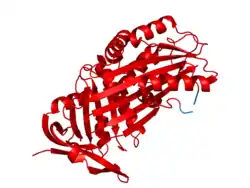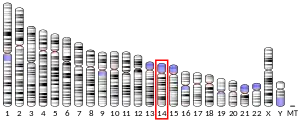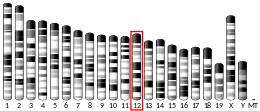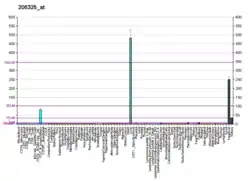Transcortin
Transcortin, also known as corticosteroid-binding globulin (CBG) or serpin A6, is a protein produced in the liver in animals. In humans it is encoded by the SERPINA6 gene. It is an alpha-globulin.[5][6][7]
| SERPINA6 | |||||||||||||||||||||||||
|---|---|---|---|---|---|---|---|---|---|---|---|---|---|---|---|---|---|---|---|---|---|---|---|---|---|
 | |||||||||||||||||||||||||
| |||||||||||||||||||||||||
| Identifiers | |||||||||||||||||||||||||
| Aliases | SERPINA6, CBG, serpin family A member 6 | ||||||||||||||||||||||||
| External IDs | OMIM: 122500 MGI: 88278 HomoloGene: 20417 GeneCards: SERPINA6 | ||||||||||||||||||||||||
| |||||||||||||||||||||||||
| |||||||||||||||||||||||||
| |||||||||||||||||||||||||
| |||||||||||||||||||||||||
| Orthologs | |||||||||||||||||||||||||
| Species | Human | Mouse | |||||||||||||||||||||||
| Entrez | |||||||||||||||||||||||||
| Ensembl | |||||||||||||||||||||||||
| UniProt | |||||||||||||||||||||||||
| RefSeq (mRNA) | |||||||||||||||||||||||||
| RefSeq (protein) | |||||||||||||||||||||||||
| Location (UCSC) | Chr 14: 94.3 – 94.32 Mb | Chr 12: 103.65 – 103.66 Mb | |||||||||||||||||||||||
| PubMed search | [3] | [4] | |||||||||||||||||||||||
| Wikidata | |||||||||||||||||||||||||
| |||||||||||||||||||||||||
Function
This gene encodes an alpha-globulin protein with corticosteroid-binding properties. This is the major transport protein for glucocorticoids and progestins in the blood of most vertebrates. The gene localizes to a chromosomal region containing several closely related serine protease inhibitors (serpins) which have evolved by duplication events.[7]
Binding
Transcortin binds several steroid hormones at high rates:
- Cortisol - Approximately 75% of the cortisol in circulation is bound to transcortin. (The rest is bound to serum albumin.) Cortisol is thought to be biologically active only when it is not bound to transcortin.
- Cortisone[8]
- Deoxycorticosterone (DOC)[8]
- Corticosterone - About 78% of serum corticosterone is bound to transcortin.
- Aldosterone - Approximately 17% of serum aldosterone is bound to transcortin, while another 47% is bound to serum albumin. The remaining 36% is free.[9]
- Progesterone - Approximately 18% of serum progesterone is bound to transcortin, while another 80% of it is bound to serum albumin. The remaining 2% is free.[10]
- 17α-Hydroxyprogesterone[8]
In addition, approximately 4% of serum testosterone is bound to transcortin.[11] A similarly small fraction of serum estradiol is bound to transcortin as well.
Clinical significance
Mutations in this gene are rare. Only four mutations have been described, often in association with fatigue and chronic pain.[13] This mechanism for these symptoms is not known. This condition must be distinguished from secondary hypocortisolism. Exogenous hydrocortisone does not appear to improve the fatigue.
Hepatic synthesis of corticosteroid-binding globulin more than doubles in pregnancy; that is, bound plasma cortisol in term pregnancy is approximately 2 to 3 times that of nonpregnant women.[14][15]
See also
- Serpin
- Circaseptan, 7-day biological cycle
References
- ENSG00000170099 GRCh38: Ensembl release 89: ENSG00000277405, ENSG00000170099 - Ensembl, May 2017
- GRCm38: Ensembl release 89: ENSMUSG00000060807 - Ensembl, May 2017
- "Human PubMed Reference:". National Center for Biotechnology Information, U.S. National Library of Medicine.
- "Mouse PubMed Reference:". National Center for Biotechnology Information, U.S. National Library of Medicine.
- Hammond GL, Smith CL, Goping IS, Underhill DA, Harley MJ, Reventos J, Musto NA, Gunsalus GL, Bardin CW (August 1987). "Primary structure of human corticosteroid binding globulin, deduced from hepatic and pulmonary cDNAs, exhibits homology with serine protease inhibitors". Proc Natl Acad Sci U S A. 84 (15): 5153–7. Bibcode:1987PNAS...84.5153H. doi:10.1073/pnas.84.15.5153. PMC 298812. PMID 3299377.
- Byth BC, Billingsley GD, Cox DW (July 1994). "Physical and genetic mapping of the serpin gene cluster at 14q32.1: allelic association and a unique haplotype associated with alpha 1-antitrypsin deficiency". Am J Hum Genet. 55 (1): 126–33. PMC 1918218. PMID 7912884.
- "Entrez Gene: SERPINA6 serpin peptidase inhibitor, clade A (alpha-1 antiproteinase, antitrypsin), member 6".
- E. Edward Bittar; Neville Bittar (1997). Molecular and Cellular Endocrinology. Elsevier. p. 238. ISBN 978-1-55938-815-3. Retrieved 23 August 2012.
- Principles and Practice of Endocrinology and Metabolism. Lippincott Williams & Wilkins. 24 April 2001. p. 712. ISBN 978-0-7817-1750-2. Retrieved 23 August 2012.
- Negi (2009). Introduction To Endocrinology. PHI Learning Pvt. Ltd. p. 268. ISBN 978-81-203-3850-0. Retrieved 23 August 2012.
- Dunn JF, Nisula BC, Rodbard D (July 1981). "Transport of steroid hormones: binding of 21 endogenous steroids to both testosterone-binding globulin and corticosteroid-binding globulin in human plasma". The Journal of Clinical Endocrinology and Metabolism. 53 (1): 58–68. doi:10.1210/jcem-53-1-58. PMID 7195404.
- Musa BU, Seal US, Doe RP (September 1965). "Elevation of certain plasma proteins in man following estrogen administration: a dose-response relationship". J. Clin. Endocrinol. Metab. 25 (9): 1163–6. doi:10.1210/jcem-25-9-1163. PMID 4284083.
- Torpy DJ, Lundgren BA, Ho JT, Lewis JG, Scott HS, Mericq V (January 2012). "CBG Santiago: a novel CBG mutation". J. Clin. Endocrinol. Metab. 97 (1): E151–5. doi:10.1210/jc.2011-2022. PMID 22013108.
- Rosen MI, Shnider SM, Levinson G, Hughes (2002). Shnider and Levinson's anesthesia for obstetrics. Hagerstwon, MD: Lippincott Williams & Wilkins. p. 13. ISBN 0-683-30665-0.CS1 maint: multiple names: authors list (link)
- Ann M. Gronowski (6 May 2004). Handbook of Clinical Laboratory Testing During Pregnancy. Springer Science & Business Media. pp. 408–. ISBN 978-1-59259-787-1.
Further reading
- Rosner W, Beers PC, Awan T, Khan MS (1976). "Identification of corticosteroid-binding globulin in human milk: measurement with a filter disk assay". J. Clin. Endocrinol. Metab. 42 (6): 1064–73. doi:10.1210/jcem-42-6-1064. PMID 932172.
- Smith CL, Power SG, Hammond GL (1992). "A Leu----His substitution at residue 93 in human corticosteroid binding globulin results in reduced affinity for cortisol". J. Steroid Biochem. Mol. Biol. 42 (7): 671–6. doi:10.1016/0960-0760(92)90107-T. PMID 1504007.
- Brotherton J (1990). "Cortisol and transcortin in human seminal plasma and amniotic fluid as estimated by modern specific assays". Andrologia. 22 (3): 197–204. doi:10.1111/j.1439-0272.1990.tb01966.x. PMID 2240617.
- Seralini GE, Bérubé D, Gagné R, Hammond GL (1991). "The human corticosteroid binding globulin gene is located on chromosome 14q31-q32.1 near two other serine protease inhibitor genes". Hum. Genet. 86 (1): 73–5. doi:10.1007/bf00205177. PMID 2253941.
- Underhill DA, Hammond GL (1990). "Organization of the human corticosteroid binding globulin gene and analysis of its 5'-flanking region". Mol. Endocrinol. 3 (9): 1448–54. doi:10.1210/mend-3-9-1448. PMID 2608068.
- Loric S, Egloff M, Domingo M, et al. (1990). "Immunochemical characterization of corticosteroid-binding globulin in human bronchoalveolar fluid". Clin. Chim. Acta. 186 (1): 19–23. doi:10.1016/0009-8981(89)90198-8. PMID 2612005.
- Heubner A, Belovsky O, Müller W, et al. (1987). "Application of liquid-liquid partition chromatography in the simultaneous purification of sex-hormone-binding globulin and corticosteroid-binding globulin". J. Chromatogr. 397: 419–34. doi:10.1016/S0021-9673(01)85027-5. PMID 2821037.
- Kato EA, Hsu BR, Kuhn RW (1988). "Comparative structural analyses of corticosteroid binding globulin". J. Steroid Biochem. 29 (2): 213–20. doi:10.1016/0022-4731(88)90268-3. PMID 3347061.
- Bardin CW, Gunsalus GL, Musto NA, et al. (1988). "Corticosteroid binding globulin, testosterone-estradiol binding globulin, and androgen binding protein belong to protein families distinct from steroid receptors". J. Steroid Biochem. 30 (1–6): 131–9. doi:10.1016/0022-4731(88)90085-4. PMID 3386241.
- Hammond GL, Langley MS (1986). "Identification and measurement of sex hormone binding globulin (SHBG) and corticosteroid binding globulin (CBG) in human saliva". Acta Endocrinol. 112 (4): 603–8. doi:10.1530/acta.0.1120603. PMID 3751467.
- Agrimonti F, Frairia R, Fornaro D, et al. (1983). "Circadian and circaseptan rhythmicities in corticosteroid-binding globulin (CBG) binding activity of human milk". Chronobiologia. 9 (3): 281–90. PMID 7172869.
- Misao R, Hori M, Ichigo S, et al. (1995). "Levels of sex hormone-binding globulin (SHBG) and corticosteroid-binding globulin (CBG) messenger ribonucleic acid (mRNAs) in ovarian endometriosis". Reprod. Nutr. Dev. 35 (2): 155–65. doi:10.1051/rnd:19950204. PMID 7734053.
- Misao R, Hori M, Ichigo S, et al. (1995). "Corticosteroid-binding globulin mRNA levels in human uterine endometrium". Steroids. 59 (10): 603–7. doi:10.1016/0039-128X(94)90055-8. PMID 7878688.
- Maruyama K, Sugano S (1994). "Oligo-capping: a simple method to replace the cap structure of eukaryotic mRNAs with oligoribonucleotides". Gene. 138 (1–2): 171–4. doi:10.1016/0378-1119(94)90802-8. PMID 8125298.
- Avvakumov GV, Hammond GL (1994). "Glycosylation of human corticosteroid-binding globulin. Differential processing and significance of carbohydrate chains at individual sites". Biochemistry. 33 (19): 5759–65. doi:10.1021/bi00185a012. PMID 8180202.
- Van Baelen H, Power SG, Hammond GL (1993). "Decreased cortisol-binding affinity of transcortin Leuven is associated with an amino acid substitution at residue-93". Steroids. 58 (6): 275–7. doi:10.1016/0039-128X(93)90072-U. PMID 8212073.
- Misao R, Nakanishi Y, Fujimoto J, et al. (1996). "Expression of corticosteroid-binding globulin mRNA in human uterine endometrial cancers". Steroids. 60 (10): 720–4. doi:10.1016/0039-128X(95)00106-Z. PMID 8539782.
- Suzuki Y, Yoshitomo-Nakagawa K, Maruyama K, et al. (1997). "Construction and characterization of a full length-enriched and a 5'-end-enriched cDNA library". Gene. 200 (1–2): 149–56. doi:10.1016/S0378-1119(97)00411-3. PMID 9373149.
External links
- Transcortin at the US National Library of Medicine Medical Subject Headings (MeSH)
- The MEROPS online database for peptidases and their inhibitors: I04.954
- SERPINA6+protein,+human at the US National Library of Medicine Medical Subject Headings (MeSH)




